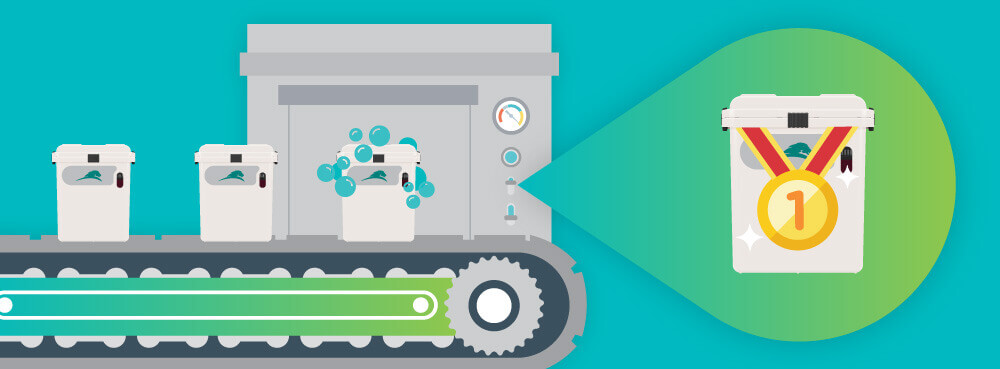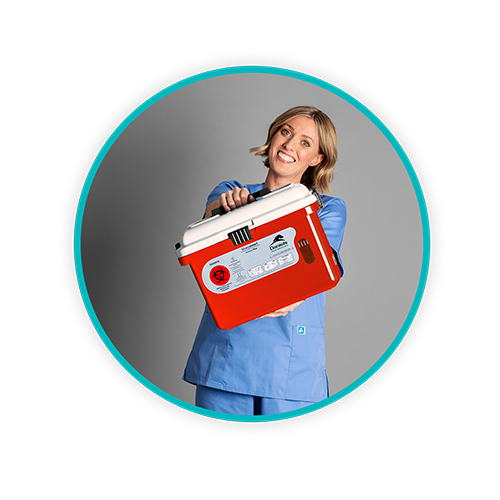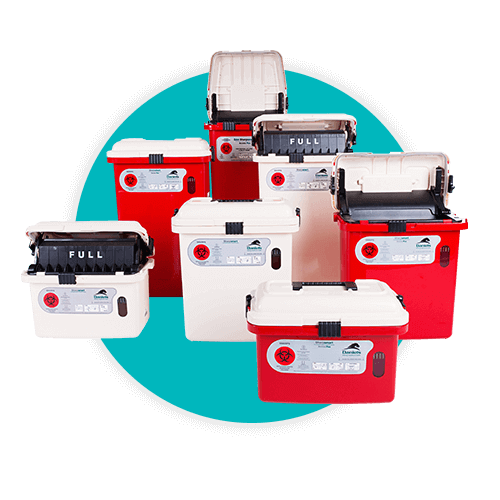Are Reusable Sharps Containers Clean?

Disposable sharps containers for sharps disposal is unfortunately still the norm—but at Daniels we do things differently. Our mission is to implement reusable medical waste containers at as many healthcare facilities as possible. Whenever ‘reusable’ is mentioned, the next question is ‘how do you ensure cleanliness?’ In the case of a sharps container this question’s importance is compounded by the fact that the majority of their use is in clinical environments requiring the highest adherence to infection prevention. We will cover from all angles of cost, cleanliness, sustainability and safety, why the switch to reusable sharps containers is worthwhile!
Can sharps containers transfer disease?
The concern of cross infection between clinical locations and hospitals is demonstrated through the increased international focus on hand hygiene, cleaning products and isolation zones. Quite simply, any question around cleanliness or infection control is not worth the patient or human risk. Sharps containers are not a patient use device and several decades of commercial use, together with guidelines from the US Centers of Disease Control1 confirm the innocuousness of sharps containers in disease transmission risk. A recent study examining C Difficile transmission potential with reusable sharps containers, categorically disproved any role that reusable sharps containers could have in transmitting C Difficile.
Are reusable sharps containers decontaminated after washing?
Prions (infectious protein particles) in a sharps container, while very unlikely, pose no risk to patients, staff or factory workers, however such probabilities are again not worth the human risk. Daniels’ approach to decontamination is “let’s assume the worst and ensure that our solution eliminates all possible risk.” Taking this approach towards the development of our world-first Sharpsmart reusable sharps container, led us to not only develop a sharps container uniquely compatible to surface cleaning within a hospital environment, but also an accompanying robotic washing process that has achieved unprecedented decontamination results and been vetted by independent microbiological testing. A study published by microbiologist Terry Grimmond attested to Daniels’ industry-leading approach to sharps and medical waste container washing via its robotic washsmart.
The Washsmart cleaning process was independently tested by coating 17 Gallon Medismart bins with 6-log blood suspensions of Staph aureus and E. Faecalis. On swabbing them after the wash, no challenge organisms were detected – this is a very high level of decontamination.
In Daniels’ robotic cleaning process, each container is robotically unlocked, decanted of contents and subjected to a 6-stage washing process that exceeds the decontamination parameters of any washing process tested for reusable containers. This process is more comprehensive than the washing stages of a hospital dishwasher! And is similar to that enforced for surgical instruments.
How Daniels deliver guaranteed excellence in container washing processes:
- Decontamination – Blood and human soiling are 100% removed, and the interior of the container is guaranteed safe for handling.
- Sanitization – Daniels robotic Washsmart system has been extensively researched, tested and independently verified to achieve a level of santization more than four times than that required by the Center of Disease Control. We don’t do things by halves!
- Quality Control Parameters – To achieve complete disinfection, Daniels closely monitor time, temperature and water volumes impacting the robotic washing process. If any parameter falls outside of the set criteria, the Daniels Washsmart machine immediately shuts down to it can be repaired.
- Ninhydrin-Level Testing – The Washsmart process passes the forensic-level Ninhydrin test in detecting traces of blood and protein.
Daniels Sharpsmart containers have been used for over 19 years in more than 2000 hospitals worldwide without a single suggestion of cross-infection.
Purchasing considerations of disposable vs reusable sharps containers
Well, there is the argument “you never have to buy a disposable sharps container again”…. Which in itself is pretty compelling! But let’s dig a little deeper.
The lifespan of a Daniels reusable Sharpsmart container is greater than 10 years with a lifecycle analysis of 500+ uses. Equating this to purchasing terms, for every single Sharpsmart container, 500 disposable sharps containers must be purchased, stored, transported, treated (along with its sharps contents), and then landfilled. Across the cradle to grave continuum, a disposable sharps container presents a far greater environmental impact than “excess plastic filling landfills”, it requires a unique allocation of resources and cost outlay in purchasing and inventory management.
The cleanliness of sharps containers is important, but what about the cabinets that house them?
Safety limitations of a disposable sharps container often necessitate the requirement of an outer housing (cabinet or support mount) that will ensure stability of the container and safe disposal of sharps. This solution poses two problems, one of safety in the risk to staff exchanging containers and finding a sharp dislodged between the sharps container and its housing, but the more grave consideration is the cleanliness risk posed by a permanent wall fixture which in many facilities, rarely gets cleaned.
The impact of reusable sharps containers on manufacturing and the environment
Our 30+ years servicing the global healthcare industry has helped us shape some pretty accurate statistics around the number of disposable sharps containers that need to be manufactured to compete with a single reusable sharps container. Even with 33 years behind us, the numbers still astound us. One of the most recent studies conducted in Loma Linda hospital in California3 revealed the following:
- Manufacturing – in a single year, 48,460 single-use sharps containers had to be manufactured to deliver the same sharps volume containment and service as 3,195 reusable sharps containers.
- Environmental Impact – In this same time period, 35,925 single-use sharps containers were landfilled while ZERO Daniels Sharpsmart containers were landfilled. When put into a scalable hospital model, the results are astounding.
- CO2 Emissions – The CO2 emissions variance between single-use sharps containers and reusable sharps containers was significant. Disposable sharps containers were responsible for 8.37 CO2 emissions per 10,000 adjusted patient days, in comparison to the 2.90 emissions rate contributed by the use of Daniels reusable sharps containers. This is a 65.3% reduction in CO2 emissions from a single hospital!
Compliance considerations of reusable sharps containers
“Not all sharps containers are created equal” – this is an indisputable fact within US healthcare and one that should be carefully examined when choosing a sharps system for your healthcare facility irrespective of whether you choose a disposable or reusable containment solution. So, what are the non-negotiables in what constitutes a safe and compliant sharps container? Firstly, ensure all sharps containers have received 510k clearances from the FDA, and also meet OSHA requirements set out in the Blood-borne Pathogen Standard.
Are reusable sharps containers right for you?
We are the first to admit that sometimes a reusable sharps container, whilst hitting all of the high notes of safety, sustainability and compliance, will simply not be a fit for every healthcare practice. If you are a dentist in New York that is required (by state law) to turn a sharps container every month and yet your sharps waste volumes wouldn’t even fill an empty coca cola can in a four-week period… a highly engineered 2-gallon reusable sharps container may not work, let’s be honest! However, if you are a nursing home, hospital, dialysis or surgical center, or ambulatory care facility… we know that reusable sharps containers will change your life! Cost, purchasing, sustainability impact and staff safety are all variables directly impacted by the transition from a disposable to reusable sharps container, and at Daniels, we are not shy in boasting that we have the safest sharps container in the world!
What next?
We would love to hear from you directly (reach out to us here) if you are interested in learning more about Daniels Sharpsmart system, otherwise spend some time working through the considerations of “switching to reusables” set out by the Sustainability Roadmap for Hospitals here.
Resources
-
Centers for Disease Control and Prevention Guidelines for Environmental Infection Control in Health-Care Facilities. Recommendations of CDC and the Healthcare Infection Control Practices Advisory Committee (HICPAC), 2003. U.S. Dept HHS, (CDC) Atlanta, GA.
-
Grimmond T. Using reusable containers for hospital waste. ReSource Aug 2009; 3:12-15.
-
McPherson et al. (2019), PeerJ, DOI 10.7717/peerj.6204
Let's Talk!
Your time is valuable, and we don’t want to play hard to get. You can either phone us directly on the details listed on our contact page, or feel free to fill out this short form and one of our team members will get back to you as quickly as possible.
